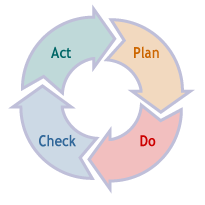Learn About Environmental Management Systems
An Environmental Management System (EMS) is a set of processes and practices that enable an organization to reduce its environmental impacts and increase its operating efficiency. This site provides information and resources related to EMS for small businesses and private industry, as well as local, state and federal agencies.
What is an EMS?

An Environmental Management System (EMS) is a framework that helps an organization achieve its environmental goals through consistent review, evaluation, and improvement of its environmental performance. The assumption is that this consistent review and evaluation will identify opportunities for improving and implementing the environmental performance of the organization. The EMS itself does not dictate a level of environmental performance that must be achieved; each organization's EMS is tailored to the its own individual objectives and targets.
Basic EMS
An EMS helps an organization address its regulatory demands in a systematic and cost-effective manner. This proactive approach can help reduce the risk of non-compliance and improve health and safety practices for employees and the public. An EMS can also help address non-regulated issues, such as energy conservation, and can promote stronger operational control and employee stewardship. Basic Elements of an EMS include the following:
- Reviewing the organization's environmental goals;
- Analyzing its environmental impacts and legal requirements;
- Setting environmental objectives and targets to reduce environmental impacts and comply with legal requirements;
- Establishing programs to meet these objectives and targets;
- Monitoring and measuring progress in achieving the objectives;
- Ensuring employees' environmental awareness and competence; and,
- Reviewing progress of the EMS and making improvements.
Costs and Benefits of an EMS
Internal
- Staff/manager time (represents the bulk of EMS resources expended by most organizations)
- Other employee time
External
- Potential consulting assistance
- Outside training of personnel
Potential Benefits
- Improved environmental performance
- Enhanced compliance
- Pollution prevention
- Resource conservation
- New customers/markets
- Increased efficiency/reduced costs
- Enhanced employee morale
- Enhanced image with public, regulators, lenders, investors
- Employee awareness of environmental issues and responsibilities
EMS under ISO 14001

An EMS encourages an organization to continuously improve its environmental performance. The system follows a repeating cycle (see figure 1). The organization first commits to an environmental policy, then uses its policy as a basis for establishing a plan, which sets objectives and targets for improving environmental performance. The next step is implementation. After that, the organization evaluates its environmental performance to see whether the objectives and targets are being met. If targets are not being met, corrective action is taken. The results of this evaluation are then reviewed by top management to see if the EMS is working. Management revisits the environmental policy and sets new targets in a revised plan. The company then implements the revised plan. The cycle repeats, and continuous improvement occurs.
The most commonly used framework for an EMS is the one developed by the International Organization for Standardization (ISO) for the ISO 14001 standard Exit. Established in 1996, this framework is the official international standard for an EMS which is based on the Plan-Do-Check-Act methodology. The five main stages of an EMS, as defined by the ISO 14001 standard Exit, are described below:
1. Commitment and Policy - Top management commits to environmental improvement and establishes the organization's environmental policy. The policy is the foundation of the EMS.
2. Planning - An organization first identifies environmental aspects of its operations. Environmental aspects are those items, such as air pollutants or hazardous waste, that can have negative impacts on people and/or the environment. An organization then determines which aspects are significant by choosing criteria considered most important by the organization. For example, an organization may choose worker health and safety, environmental compliance, and cost as its criteria. Once significant environmental aspects are determined, an organization sets objectives and targets. An objective is an overall environmental goal (e.g., minimize use of chemical X). A target is a detailed, quantified requirement that arises from the objectives (e.g., reduce use of chemical X by 25% by September 1998). The final part of the planning stage is devising an action plan for meeting the targets. This includes designating responsibilities, establishing a schedule, and outlining clearly defined steps to meet the targets.
3. Implementation - A organization follows through with the action plan using the necessary resources (human, financial, etc.). An important component is employee training and awareness for all employees. Other steps in the implementation stage include documentation, following operating procedures, and setting up internal and external communication lines.
4. Evaluation - A company monitors its operations to evaluate whether targets are being met. If not, the company takes corrective action.
5. Review - Top management reviews the results of the evaluation to see if the EMS is working. Management determines whether the original environmental policy is consistent with the organization's values. The plan is then revised to optimize the effectiveness of the EMS. The review stage creates a loop of continuous improvement for a company.
